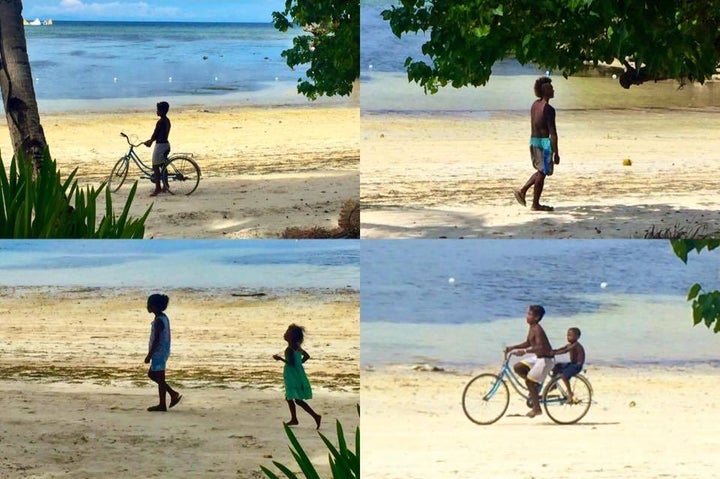While anti-immigrant rhetoric has existed in the United States for decades, recent debates about who is considered “really American” have always baffled me. Although most Black Americans are descendants of Africans who were forced into the Western Hemisphere via the atrocities of slavery, a majority of White Americans can trace their roots to immigration over the past few centuries. Most of those European immigrants didn’t have papers or documents; there weren’t requirements for citizenship, nor were there bans of people arriving from Europe. They came freely with the possibility for opportunities and the pursuit of the American Dream.
However, many Americans forget that indigenous people have been living in what is now the United States for at least 12,000 years. When European colonizers declared the continental US as their own (along with other parts of the Americas and the Pacific Islands), they killed millions of indigenous people who got in their way. In the US, English colonizers stripped Native people of their properties and lands, and they forced indigenous children into assimilation schools. Across the Pacific, American colonizers overthrew the Hawaiian monarchy and the US government annexed Hawai’i as their own. Over time, both the Native American & Native Hawaiian populations have dwindled, with Native Americans comprising only 2% of the total U.S. population and Native Hawaiians comprising only 10% of Hawai’i.
Despite this history, the genocide of indigenous people has been reframed to fit a colonial narrative. American history teachers indoctrinate students to believe that colonization made our country great, despite the means that were used to achieve this. American children learn that Thanksgiving commemorated Native Americans’ welcoming of English settlers, in spite of actual tensions between the two groups. Americans are taught to celebrate our independence on July 4, 1776, without recognizing that African Americans were still considered slaves at this time and that Native Americans were not granted American citizenship until 1924. In omitting this part of American history, it appears that our country’s leaders have been spewing “alternative facts” for centuries.
On my recent trip to the Philippines with my husband, we spent half of our time in my parents’ home province of Aklan and the second half in Metro Manila (where my husband’s father is from). While parts of Manila reminded me of big cities like New York or Los Angeles, I learned most while in rural Aklan. Although there was a strong American presence everywhere in the Philippines, the local people of Aklan spoke less English, which allowed me to practice my parents’ native Aklanon language. There was also less tourism, which helped me to imagine what pre-colonial Philippines could have been like.

Ati children in Boracay, Philippines
One morning, while writing on an isolated beach of Western Boracay, I was distracted and fascinated by the many children passing by. Because they phenotypically presented as Black, I gathered that they were Ati – a group of darker-skinned indigenous Filipinos who lived in Aklan for centuries. Generally, Ati people are also smaller in stature and have kinky hair. When the Spanish arrived (and colonized) the Philippines in the 1500s, Ati people were classified as part of a larger group called Negritos (a term which literally translates to "little Black people").
Anthropologists claim that the Ati people (and other Negritos from other parts of the Philippines) derived from aboriginal Australia over 25,000 years ago. However, oral history suggests that Negritos may have come even earlier from parts of Africa. When people of the Malay race (i.e., the group that a majority of Filipino people would be phenotypically classified as today) arrived in the Philippines, Ati people (and other Negritos) were pushed out of their own land. In fact, the Ati children who I saw emerged from a small tree-covered land mass that was about 15 feet from the shore.
Generally, Ati people and other Negritos in the Philippines are way poorer than the general population; they tend to die early or have poor health conditions; and they are heavily discriminated against by other Filipinos who view them as intellectually inferior or uncivilized. Like indigenous people in the US and the Pacific Islands, they have been displaced from, or forced out of, the lands of their ancestors. Like Black people in the US and across the African diaspora, they are negatively stereotyped because of their race. And like any marginalized group, they experience an array of health and educational disparities that can negatively impact their ability to survive or thrive.
While it is clear that centuries of colonization and colorism contribute significantly to the marginalization of indigenous people in the Philippines (and across the world), it is important for Filipinos (and Filipino Americans) to pay respects to indigenous people who once inhabited the 7000 islands that we now call the Philippines. Perhaps this is why former President Benigno Aquino first declared International Indigenous Peoples Day (August 9) in the Philippines in 2015. I hope that this annual commemoration is not one that is overlooked or celebrated superficially. Instead, I hope that Filipino people can really reflect on, and truthfully teach their children about, the genocide of the indigenous people in the Philippines and beyond. In doing so, we do our parts to decolonize our minds, while paying homage to the many ancestors who lost their lives, their livelihoods, or both.
On a personal note, I learned from a genetic report a few years ago that while I am 97% Southeast Asian heritage, that I am also 2.4% Southern European. This likely means that 5 or 6 generations ago, I have a Spanish great, great, great grandparent. I also learned that I am 0.2% Subsaharan African - which means that approximately 9 or 10 generations ago, I have a distant family member with African roots. While I will never know who this ancestor is, could she or he possibly be Ati?
Nevertheless, to commemorate International Indigenous Peoples Day, I offer a video of ANC Reporter Annalisa Burgos, Dr. E.J.R. David, and Attorney Jeanette Florita discussing indigenous peoples’ rights in the Philippines.
